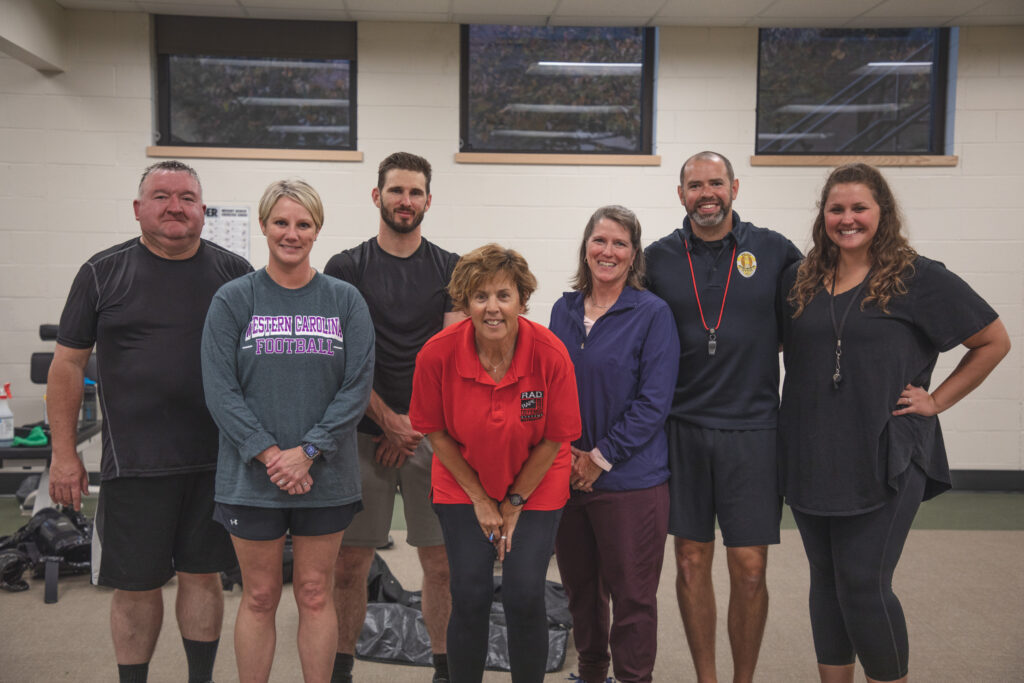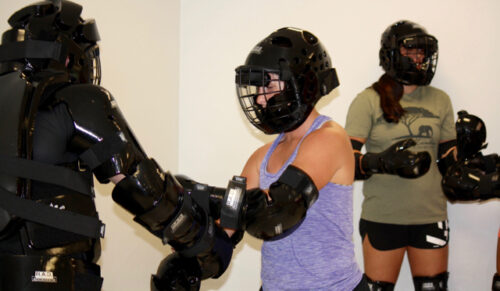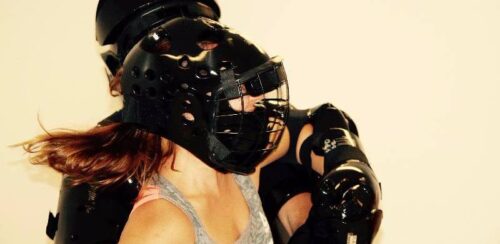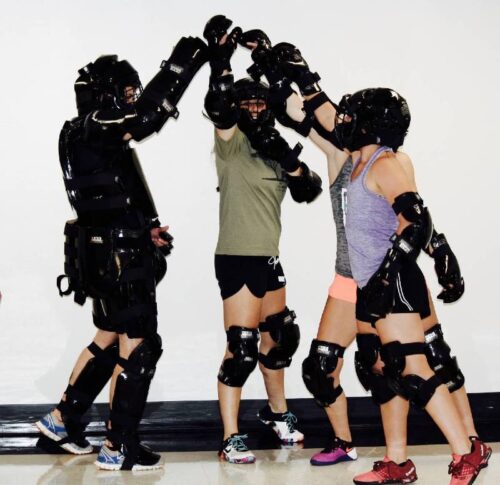
30 young women completed a circle around the poorly lit room in the back of the gym. Hearts beating fast from their warm-up, sweat building on foreheads, heavy breathing, and wide eyes looking to their instructors in the middle of the circle for commands to start their drills.
“Defensive stance,” yelled instructor Gayle Maddox, turning to look at the women as she spoke. A smile curling at the edge of her lips, “Ready!”
“NO!” the women yelled in unison.
They stepped back slightly with their right legs and raised their arms into position. Right hand fisted by their waists and the left flattened vertically in front of their faces, just below eye level.
“I’m sorry, I couldn’t hear you,” said Maddox. The class chuckled and relaxed, preparing to snap to their stance again. “I want us to scare the man working at the equipment desk over there,” Maddox shouted. “Ready!”
Getting back into position, the class responded with a louder firm, “NO!”
Satisfied smirks scattered on faces around the circle as the ‘no’ echoed against the cinder-block walls and back at them. Maddox’s smile grew to her ears and eyes, “Good.”
Learning to use their voices, to firmly say ‘no,’ and hold their ground is the most fundamental element of any Rape Aggression Defense class. The first step in a line of defenses that the girls will hopefully never have to use.
By the time 7 p.m. rolled around, the class was happily exhausted. Having run through their drills of punching and kicking, whacking the poor training dummy around, and practicing breaking grips with their classmates, the consensus was that they were ready for a long night’s sleep.
Before she dismissed them, Maddox told the women that they were one of the best classes she’d had in nearly 30 years of teaching the RAD program. And although the students laughed it off, sure that was just something told to everyone, she’d meant it. She’d seen the girls change throughout the semester. The ‘no’s’ becoming firmer and louder, their confidence building. It didn’t feel like long ago when she was in their shoes.
Fresh out of graduate school, Maddox worked as an admissions counselor at Carson-Newman University. Because she traveled often for her job, not to mention was friends with one of the instructors who was visiting from the University of Tennessee for this class, she decided to take RAD. Before completing the program she’d fallen in love with it and how empowering it was. So when asked if she was interested in being an instructor the only answer was ‘absolutely.’ Maddox went to training in 1993, then taught RAD at CN for 13 years.
In 2006, she arrived at Western Carolina University as a new Health and Physical Education professor. She’d known the university didn’t have a RAD program, and in all honesty, it wasn’t high on her to-do list. But the longer she was at WCU, the more she saw the need for it here. Inevitably, she decided to team up with other professors and departments on campus to get things started.
After quite a long approval process, in 2009 students walked into WCU’s first full-semester RAD class. Not only open to learning to defend themselves, but excited to have a community of women to feel strong and powerful with. According to Maddox, throughout the years the physical techniques taught in the class haven’t changed much but the topics they discuss have. Projects to collect examples of how stereotypes are forced on women by the media, and hard conversations about the sexual assault rates for American women.

Though the program currently offers only one session of the RAD course in both the Fall and Spring semesters, it has continued to expand through their partnership with WCU’s Police Department.
UPD offers RAD express courses for students that are anywhere between 1-12 hours long to teach the basics of self-defense. Since the official RAD class is very popular, it’s usually filled within the first few days of registration by seniors, so these express classes offer a brief insight to the program and the fundamental basics of physical self-defense but don’t go nearly as in-depth as the full semester courses.
RAD express courses also don’t have the final exam of the semesterly course – simulation. UPD officers come to the last day of class in padded suits and run simulation attack scenarios with the women, so they can practice their new skills in full force.
“We couldn’t run the program without the help of UPD, especially regarding simulation,” said Maddox.
Simulation
The tension in the air was palpable as the girls started strapping on their pads and lining up to begin their first rounds through simulation. There is no air conditioning in the old Reid gym so as the girls suited up, the heat mixed with anticipation made the air even thicker. They were given a helmet, knee and elbow pads, and a close relative of boxing gloves for protection. In minutes girls were swarming the lone fan, squeaks of protests from their pads following their movements.

Assisting UPD officers Tammy Pavey and Jacob Deal gathered the room’s attention to explain what the night entailed. The simulations were to take place at the back of the gym, and students waiting for their turn must line up around the corner. That way they can hear what’s happening and celebrate with their classmates once they pass, but not have the scenario given to them ahead of time.
After a quick check of everyone’s gear, and Velcro locking the pads onto UPD Chief Steve Lillard, the first girl was walked around the corner by Tammy Pavey.
Pavey made a good attempt at keeping the girl in casual conversation as they walked to the center of the back room. She was instructed to walk along a taped line on the ground until the ‘attacker,’ Chief Lillard, made the first move. Even though she was expecting it, between the padding and the fact that the man inside it stood a head taller than her, it scared her when he firmly grabbed her wrist.

But all nervousness left as soon as her adrenaline kicked in. Without thinking she was shouting her ‘no’s,’ and pounding on a nerve in his arm with her fist until he released her. Still yelling for help, she stomped on his foot and ran as fast as she could from the back room. Turning the corner, the fear she felt seconds before dissolved into pride as her classmates shouted in encouragement and applauded.
One of the key benefits of this course according to Alyssa Sinyard, Maddox’s current partner instructor, is how different women feel once they’ve gone through this course. The instructors see a day-and-night difference between the women that walk into their class for the first time and leave for the last.
According to Rainn’s Campus Sexual Violence Statistics, 26.4% of undergraduate females will experience rape or sexual assault through physical force, violence, or incapacitation. Cornell University’s Street Harassment Statistics also reported that 85% of women will experience street harassment (catcalling) before the age of 17.
For a long time, it’s become the responsibility of women to ‘just deal with it.’ To avoid walking alone at night, to not wear revealing clothing, and to always have a can of pepper spray ready. That pressure of always having to look over their shoulders takes its toll.
“Whether or not you’ve actually been assaulted, it makes you feel assaulted,” said Sinyard. “I think a lot of women don’t really understand that they have a voice. They think ‘oh I put myself in these situations now I have to deal with it.’ But it’s an empowering concept, just being able to say ‘no, get away from me and take the power back into your own hands rather than be a victim.”
Aubrey Ray Dalana, one of the first RAD students at WCU and now a certified instructor, is a prime example of how the program can stick with its students. She fell in love with the program the same way that Maddox did, has taught RAD for a few years at Western, and is helping the program plan for the future. Potentially expanding it to include more sessions each semester, and help members of the LGBTQ+ community as well as women.
Maddox has played a tremendous part in bringing RAD to WCU, though she’s adamant that she wouldn’t have been able to establish this on her own. She greatly credits previous RAD instructors, Aubrey Dalana’s involvement, and the cooperation with UPD for making this program come to life and change women for the better.


